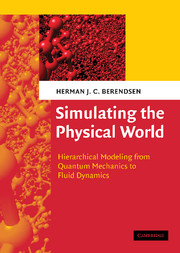Book contents
- Frontmatter
- Contents
- Preface
- Symbols, units and constants
- Part I A Modeling Hierarchy for Simulations
- Part II Physical and Theoretical Concepts
- 12 Fourier transforms
- 13 Electromagnetism
- 14 Vectors, operators and vector spaces
- 15 Lagrangian and Hamiltonian mechanics
- 16 Review of thermodynamics
- 17 Review of statistical mechanics
- 18 Linear response theory
- 19 Splines for everything
- References
- Index
18 - Linear response theory
Published online by Cambridge University Press: 05 June 2012
- Frontmatter
- Contents
- Preface
- Symbols, units and constants
- Part I A Modeling Hierarchy for Simulations
- Part II Physical and Theoretical Concepts
- 12 Fourier transforms
- 13 Electromagnetism
- 14 Vectors, operators and vector spaces
- 15 Lagrangian and Hamiltonian mechanics
- 16 Review of thermodynamics
- 17 Review of statistical mechanics
- 18 Linear response theory
- 19 Splines for everything
- References
- Index
Summary
Introduction
There are many cases of interest where the relevant question we wish to answer by simulation is “what is the response of the (complex) system to an external disturbance?” Such responses can be related to experimental results and thus be used not only to predict material properties, but also to validate the simulation model. Responses can either be static, after a prolonged constant external disturbance that drives the system into a non-equilibrium steady state, or dynamic, as a reaction to a time-dependent external disturbance. Examples of the former are transport properties such as the heat flow resulting from an imposed constant temperature gradient, or the stress (momentum flow) resulting from an imposed velocity gradient. Examples of the latter are the optical response to a specific sequence of laser pulses, or the time-dependent induced polarization or absorption following the application of a time-dependent external electric field.
In general, responses can be expected to relate in a non-linear fashion to the applied disturbance. For example, the dielectric response (i.e., the polarization) of a dipolar fluid to an external electric field will level off at high field strengths when the dipoles tend to orient fully in the electric field. The optical response to two laser pulses, 100 fs apart, will not equal the sum of the responses to each of the pulses separately. In such cases there will not be much choice other than mimicking the external disturbance in the simulated system and “observing” the response.
- Type
- Chapter
- Information
- Simulating the Physical WorldHierarchical Modeling from Quantum Mechanics to Fluid Dynamics, pp. 505 - 522Publisher: Cambridge University PressPrint publication year: 2007

